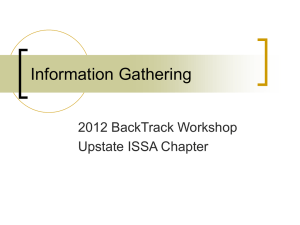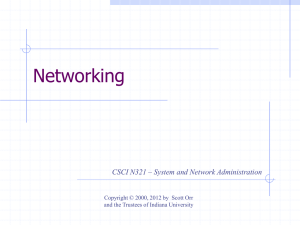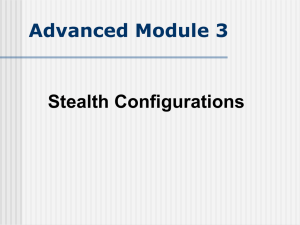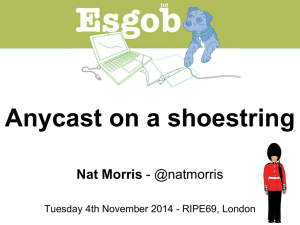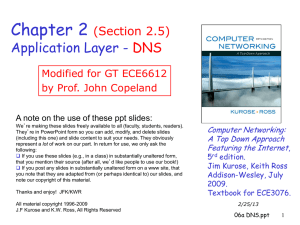DNS
advertisement
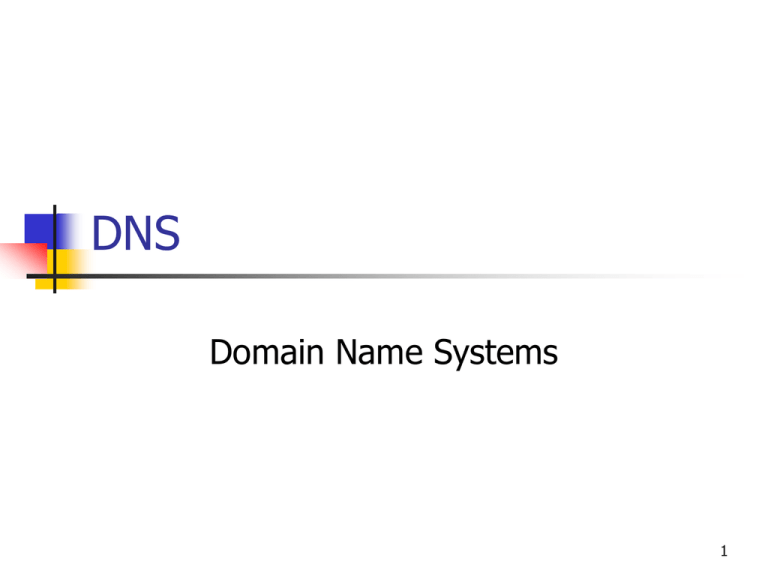
DNS Domain Name Systems 1 Domain Name System DNS Overview DNS Zones Forward Reverse Fowarding DNS Delegation/Parenting Mail Exchangers 2 DNS Overview http://en.wikipedia.org/wiki/Dns 3 Overview On the Internet, the Domain Name System (DNS) associates various sorts of information with domain names Serves as the "phone book" for the Internet Translates human-readable computer hostnames into IP addresses Also stores other information Required bynetworking equipment to delivering information Such as the list of mail exchange servers that accept email for a given domain. By providing a worldwide keyword-based redirection service, the Domain Name System is an essential component of the modern Internet 4 Uses 5 Uses The most basic use of DNS is to translate hostnames to IP addresses. Very much like a phone book For example, what is the internet address of en.wikipedia.org? The Domain Name System can be used to tell you it is 66.230.200.100 6 Uses DNS also has other important uses DNS makes it possible Assign Internet destinations to the human organization or concern they represent Independent of the physical routing hierarchy represented by the numerical IP address. Hyperlinks and Internet contact information can remain the same Whatever the current IP routing arrangements may be Can take a human-readable form (such as "wikipedia.org") Easier to remember than an IP address (such as 66.230.200.100). People take advantage of this when they recite meaningful URLs and e-mail addresses Do not need to care how the machine will actually locate them 7 Uses The Domain Name System distributes the responsibility for assigning domain names and mapping them to IP networks allows an authoritative server for each domain to keep track of its own changes avoids the need for a central registrar to be continually consulted and updated 8 History 9 History Using a name as a more human-legible abstraction of a machine's numerical address on the network predates even TCP/IP All the way to the ARPAnet era Back then however, a different system was used, as DNS was only invented in 1983, shortly after TCP/IP was deployed. With the older system, each computer on the network retrieved a file called HOSTS.TXT from a computer at SRI (now SRI International). The HOSTS.TXT file mapped numerical addresses to names. A hosts file still exists on most modern operating systems, either by default or through configuration Allows users to specify an IP address (eg. 192.0.34.166) to use for a hostname (eg. www.example.net) without checking DNS. Nowadays, the hosts file serves primarily for troubleshooting DNS errors or for mapping local addresses to more organic names Systems based on a hosts file have inherent limitations The obvious requirement that every time a given computer's address changed, every computer that seeks to communicate with it would need an update to its hosts file On Windows: C:\WINDOWS\system32\drivers\etc> 10 History The growth of networking called for a more scalable system Records a change in a host's address in one place only Other hosts would learn about the change dynamically through a notification system Completes a globally accessible network of all hosts' names and their associated IP Addresses 11 History At the request of Jon Postel, Paul Mockapetris invented the Domain Name System in 1983 and wrote the first implementation. The original specifications appear in RFC 882 and 883 In 1987, the publication of RFC 1034 and RFC 1035 updated the DNS specification Made RFC 882 and RFC 883 obsolete. Several more-recent RFCs have proposed various extensions to the core DNS protocols. 12 History In 1984, four Berkeley students1 wrote the first UNIX implementation In 1985 Kevin Dunlap of DEC significantly re-wrote the DNS implementation Renamed it BIND (Berkeley Internet Name Domain) BIND was ported to the Windows NT platform in the early 1990s. Due to BIND's long history of security issues and exploits, several alternative nameserver/resolver programs have been written and distributed in recent years. 1Douglas Terry, Mark Painter, David Riggle and Songnian Zhou 13 How DNS works Theory 14 How DNS Works - Theory Domain names Arranged in a tree Cut into zones Each served by a nameserver 15 How DNS Works - Theory The domain name space consists of a tree of domain names. Each node or leaf in the tree has one or more resource records, which hold information associated with the domain name. The tree sub-divides into zones. A zone consists of a collection of connected nodes authoritatively served by an authoritative DNS nameserver. Note that a single nameserver can host several zones 16 How DNS Works - Theory When a system administrator wants to let another administrator control a part of the domain name space within his or her zone of authority Can delegate control to the other administrator. Splits a part of the old zone off into a new zone Comes under the authority of the second administrator's nameservers The old zone becomes no longer authoritative for what goes under the authority of the new zone. 17 How DNS Works - Theory A resolver looks up the information associated with nodes. A resolver knows how to communicate with name servers by sending DNS requests, and heeding DNS responses. Resolving usually entails iterating through several name servers to find the needed information. Some resolvers function simplistically and can only communicate with a single name server. These simple resolvers rely on a recursing name server to perform the work of finding information for them. 18 How DNS Works - Theory Parts of a domain name A domain name usually consists of two or more parts (labels), separated by dots Example: wikipedia.org. The rightmost label conveys the top-level domain The address en.wikipedia.org has the top-level domain org Each label to the left specifies a subdivision or subdomain of the domain above it. Note that "subdomain" expresses relative dependence, not absolute dependence: wikipedia.org comprises a subdomain of the org domain en.wikipedia.org comprises a subdomain of the domain wikipedia.org 19 How DNS Works - Theory Parts of a domain name A domain name usually consists of two or more parts (labels), separated by dots In theory this subdivision can go down to 127 levels deep each label can contain up to 63 characters the whole domain name does not exceed a total length of 255 characters In practice some domain registries have shorter limits than that. 20 How DNS works in theory Parts of a domain name A hostname refers to a domain name that has one or more associated IP addresses For example, the en.wikipedia.org and wikipedia.org domains are both hostnames, but the org domain is not The Domain Name System consists of a hierarchical set of DNS servers Each domain or subdomain has one or more authoritative DNS servers that publish information about that domain and the name servers of any domains "beneath" it. The hierarchy of authoritative DNS servers matches the hierarchy of domains At the top of the hierarchy stand the root nameservers: the servers to query when looking up (resolving) a toplevel domain name (TLD) 21 How DNS works in theory Parts of a domain name Iterative and recursive queries: Iterative query: the DNS server may provide a partial answer to the query (or give an error) DNS servers must support non-recursive queries. Recursive query: the DNS server will fully answer the query (or give an error) DNS servers are not required to support recursive queries and both the resolver (or another DNS acting recursively on behalf of another resolver) negotiate use of recursive service using bits in the query headers 22 How DNS works in theory Address resolution mechanism A full host name may have several name segments In practice full host names typically consist of three segments Using an iterative search procedure At each step along the way, the program queries a corresponding DNS server to provide a pointer to the next server which it should consult. Example: ahost.inadomain.example www.inadomain.example Software interprets the name segment by segment, right to left e.g ahost.ofasubnet.ofabiggernet.inadomain.example A DNS recursor consults three nameservers to resolve the address www.wikipedia.org. (This description deliberately uses the fictional .example TLD in accordance with the DNS guidelines themselves.) 23 How DNS works in theory Address resolution mechanism As originally envisaged, the process was as simple as: The local system is pre-configured with the known addresses of the root servers in a file of root hints Needed to be updated periodically by the local administrator from a reliable source to be kept up to date with the changes which occur over time Query one of the root servers to find the server authoritative for the next level down Query this second server for the address of a DNS server with detailed knowledge of the second-level domain Repeat the previous step to progress down the name, until the final step which would return the final address sought (This description deliberately uses the fictional .example TLD in accordance with the DNS guidelines themselves.) 24 How DNS works in theory Address resolution mechanism The diagram illustrates this process for the real host www.wikipedia.org. (This description deliberately uses the fictional .example TLD in accordance with the DNS guidelines themselves.) 25 How DNS works in theory Address resolution mechanism A search done in this simple form has a major problem: a huge operating burden on the root servers Root nameservers are critical to the overall function of the system each and every search for an address would be started by querying one of them Such a heavy use would create an insurmountable bottleneck for trillions of queries placed every day In practice preemptive measures are taken (This description deliberately uses the fictional .example TLD in accordance with the DNS guidelines themselves.) 26 How DNS works in theory Circular dependencies and glue records Name servers in delegations appear listed by name, rather than by IP address. This means that a resolving name server must issue another DNS request to find out the IP address of the server to which it has been referred Since this can introduce a circular dependency if the nameserver referred to is under the domain that it is authoritative of, it is occasionally necessary for the nameserver providing the delegation to also provide the IP address of the next nameserver This record is called a glue record 27 How DNS works in theory Circular dependencies and glue records For example, assume that the sub-domain en.wikipedia.org contains further sub-domains (such as something.en.wikipedia.org) and that the authoritative nameserver for these is at ns1.en.wikipedia.org A computer trying to resolve something.en.wikipedia.org will thus first have to resolve ns1.en.wikipedia.org Since ns1 is also under the en.wikipedia.org subdomain, resolving ns1.en.wikipedia.org requires resolving ns1.en.wikipedia.org which is exactly the circular dependency mentioned above The dependency is broken by the glue record in the nameserver of wikipedia.org that provides the IP address of ns1.en.wikipedia.org directly to the requestor, enabling it to bootstrap the process by figuring out where ns1.en.wikipedia.org is located 28 How DNS Works In Practice 29 How DNS Works In Practice When an application tries to find the IP address of a domain name It doesn't necessarily follow all of the steps outlined in the Theory section Uses caching 30 How DNS works In practice Caching and time to live Huge volume of requests generated by a system like DNS Need to provide a mechanism to reduce the load on individual DNS servers DNS resolution process allows for caching for a given period of time after a successful answer Caching: the local recording and subsequent consultation of the results of a DNS query How long a resolver caches a DNS response is determined by a value called the time to live (TTL) The TTL is set by the administrator of the DNS server handing out the response The period of validity may vary from just seconds to days or even weeks or years 31 How DNS Works In Practice - Caching time As a consequence of the distributed and caching architecture, changes to DNS do not always take effect immediately and globally This is best explained with an example: An administrator has set a TTL of 6 hours for the host www.wikipedia.org The period between 12:01pm and 6:00pm in this example is called caching time Then changes the IP address to which www.wikipedia.org resolves at 12:01pm Administrator must consider that a person who cached a response with the old IP address at 12:00pm will not consult the DNS server again until 6:00pm. The period of time that begins when you make a change to a DNS record and ends after the maximum amount of time specified by the TTL expires This essentially leads to an important logistical consideration when making changes to DNS: not everyone is necessarily seeing the same thing you're seeing. RFC 1537 helps to convey basic rules for how to set the TTL. 32 How DNS Works In Practice - Caching time Note that the term "propagation", although very widely used in this context, does not describe the effects of caching well Specifically, it implies that [1] when you make a DNS change, it somehow spreads to all other DNS servers (instead, other DNS servers check in with yours as needed) [2] that you do not have control over the amount of time the record is cached you control the TTL values for all DNS records in your domain except your NS records and any authoritative DNS servers that use your domain name 33 How DNS Works In Practice - Caching time Some resolvers may override TTL values Protocol supports caching up to 68 years no caching at all Negative caching (the non-existence of records) is determined by name servers authoritative for a zone which MUST include the SOA record (Start Of Authority) when reporting no data of the requested type exists. The MINIMUM field of the SOA record and the TTL of the SOA itself is used to establish the TTL for the negative answer 34 How DNS Works In Practice - Caching time Many people incorrectly refer to a mysterious 48 hour or 72 hour propagation time when you make a DNS change. When one changes the NS records for one's domain or the IP addresses for hostnames of authoritative DNS servers using one's domain (if any), there can be a lengthy period of time before all DNS servers use the new information Those records are handled by the zone parent DNS servers Typically cache those records for 48 hours However, those DNS changes will be immediately available for any DNS servers that do not have them cached And any DNS changes on your domain other than the NS records and authoritative DNS server names can be nearly instantaneous, if you choose for them to be (by lowering the TTL once or twice ahead of time, and waiting until the old 35 TTL expires before making the change) How DNS Works In Practice - In the Real World DNS resolving from program to OS-resolver to ISP-resolver to greater system. Users generally do not communicate directly with a DNS resolver Instead DNS-resolution takes place transparently in client-applications such as web-browsers, mailclients, and other Internet applications When an application makes a request which necessitates a DNS lookup Such programs send a resolution request to the local DNS resolver in the local operating system Which in turn handles the communications required 36 How DNS Works In Practice - In the Real World The DNS resolver will almost invariably have a cache containing recent lookups If the cache can provide the answer to the request, the resolver will return the value in the cache to the program that made the request If the cache does not contain the answer, the resolver will send the request to one or more designated DNS servers In the case of most home users, the Internet Service Provider to which the machine connects will usually supply this DNS server: Such a user will either have configured that server's address manually or allowed DHCP to set it System administrators have configured systems to use their own DNS servers Their DNS resolvers point to separately maintained nameservers of the organization In any event, the name server thus queried will follow the process outlined above Until it either successfully finds a result or does not It then returns its results to the DNS resolver Assuming it has found a result, the resolver duly caches that result for future use Hands the result back to the software which initiated the request 37 How DNS Works In Practice - Broken Resolvers Broken resolvers An additional level of complexity emerges when resolvers violate the rules of the DNS protocol Some people have suggested that a number of large ISPs have configured their DNS servers to violate rules (presumably to allow them to run on less-expensive hardware than a fully-compliant resolver), such as by disobeying TTLs, or by indicating that a domain name does not exist just because one of its name servers does not respond As a final level of complexity, some applications (such as webbrowsers) also have their own DNS cache, in order to reduce the use of the DNS resolver library itself. This practice can add extra difficulty when debugging DNS issues, as it obscures the freshness of data, and/or what data comes from which cache. These caches typically use very short caching times — of the order of one minute Internet Explorer offers a notable exception: recent versions cache DNS records for half an hour 38 How DNS Works In Practice - Other Applications The system outlined above provides a somewhat simplified scenario. The Domain Name System includes several other functions: Hostnames and IP addresses do not necessarily match on a one-toone basis. Many hostnames may correspond to a single IP address: combined with virtual hosting Alternatively a single hostname may correspond to many IP addresses: Facilitates fault tolerance and load distribution Allows a site to move physical location seamlessly Many uses of DNS besides translating names to IP addresses this allows a single machine to serve many web sites E.g. Mail transfer agents use DNS to find out where to deliver e-mail for a particular address The domain to mail exchanger mapping provided by MX records accommodates another layer of fault tolerance and load distribution on top of the name to IP address mapping 39 How DNS Works In Practice - Other Applications Sender Policy Framework and DomainKeys Instead of creating their own record types Designed to take advantage of another DNS record type, the TXT record To provide resilience in the event of computer failure, multiple DNS servers are usually provided for coverage of each domain, and at the top level, thirteen very powerful root servers exist, with additional "copies" of several of them distributed worldwide via Anycast DNS primarily uses UDP on port 53 to serve requests. Almost all DNS queries consist of a single UDP request from the client followed by a single UDP reply from the server TCP comes into play only when the response data size exceeds 512 bytes, or for such tasks as zone transfer Some operating systems such as HP-UX are known to have resolver implementations that use TCP for all queries, even when UDP would suffice 40 DNS Extensions Extensions to DNS EDNS is an extension of the DNS protocol Enhances the transport of DNS data in UDP packages Adds support for expanding the space of request and response codes Described in RFC 2671 41 Types of DNS records Important categories of data stored in DNS include the following: An A record or address record maps a hostname to a 32-bit IPv4 address. An AAAA record or IPv6 address record maps a hostname to a 128-bit IPv6 address. A CNAME record or canonical name record is an alias of one name to another An MX record or mail exchange record maps a domain name to a list of mail exchange servers for that domain. A PTR record or pointer record maps an IPv4 address to the canonical name for that host. The A record to which the alias points can be either local or remote - on a foreign name server. This is useful when running multiple services (like an FTP and a webserver) from a single IP address. Each service can then have its own entry in DNS (like ftp.example.com. and www.example.com.) Setting up a PTR record for a hostname in the in-addr.arpa. domain that corresponds to an IP address implements reverse DNS lookup for that address. For example (at the time of writing), www.icann.net has the IP address 192.0.34.164, but a PTR record maps 164.34.0.192.in-addr.arpa to its canonical name, referrals.icann.org. An NS record or name server record maps a domain name to a list of DNS servers authoritative for that domain. Delegations depend on NS records. 42 Types of DNS records Important categories of data stored in DNS include the following: (cont.) An SOA record or start of authority record specifies the DNS server providing authoritative information about an Internet domain, the email of the domain administrator, the domain serial number, and several timers relating to refreshing the zone. An SRV record is a generalized service location record. A TXT Record allows an administrator to insert arbitrary text into a DNS record. For example, this record is used to implement the Sender Policy Framework and DomainKeys specifications. NAPTR records ("Naming Authority Pointer") are a newer type of DNS record that support regular expression based rewriting. Other types of records simply provide information (for example, a LOC record gives the physical location of a host), or experimental data (for example, a WKS record gives a list of servers offering some well known service such as HTTP or POP3 for a domain). When sent over the internet, all records use the common format specified in RFC 1035 shown below. RR (Resource Record) Fields FieldDescriptionLength (Octets)NAMEName of the node to which this record pertains.(variable)TYPEType of RR. For example, MX is type 15.2CLASSClass code.2TTLSigned time in seconds that RR stays valid.4RDLENGTHLength of RDATA field.2RDATAAdditional RR-specific data.(variable)For a complete list of DNS Record types consult IANA DNS Parameters. 43 DNS Records – Complete List http://www.iana.org/assignments/dnsparameters 44 Example DNS Record for logicbbs.org IN NS ns.planix.com IN NS ns1.mydyndns.org IN NS ns2.mydyndns.org First three lines describe valid name servers for logicbbs.org. Following two entries indicate that the mail exchanger for logicbbs.org has a priority of 10 and messages should be directed to mail.logicbbs.org. Priority values indicate where to send e-mail if a server is unavailable; the lower the priority value, the higher the priority of that server. IN MX 10 mail IN A 69.17.158.109 www IN A 69.17.158.109 mail IN A 69.17.158.109 The last two lines indicate that logicbbs.org (the secondlevel domain) points to 69.17.158.109. Mail servers send e-mail to the server with the lowest priority value, and then work their way up the values listed as necessary. The www and mail subdomains (www.logicbbs.org, mail.logicbbs.org) also point to 69.17.158.109. The DNS record is the reason why some internet addresses do not need the www prefix, while others do. If that particular domain has a www A record that differs from the basic A record, then anydomain.com may be different from www.anydomain.com, and the former may not work. Other sites, like logicbbs.org, have both the top-level domain and the www subdomain pointing to the same IP address, which reduces confusion and ambiguity 45 Internationalized Domain Names While domain names technically have no restrictions on the characters they use and can include non-ASCII characters, the same is not true for host names Host names are the names most people see and use for things like e-mail and web browsing. Host names are restricted to a small subset of the ASCII character set that includes the the the the Roman alphabet in upper and lower case digits 0 through 9 dot hyphen This prevented the native representation of names and words of many languages ICANN has approved the Punycode-based IDNA system, which maps Unicode strings into the valid DNS character set, as a workaround to this issue Some registries have adopted IDNA 46 Security issues DNS was not originally designed with security in mind, and thus has a number of security issues. DNS responses are traditionally not cryptographically signed, leading to many attack possibilities; Even with encryption it still doesn't prevent the possibility that a DNS server could become infected with a virus (or for that matter a disgruntled employee) that would cause IP addresses of that server to be redirected to a malicious address with a long TTL. DNSSEC modifies DNS to add support for cryptographically signed responses There are various extensions to support securing zone transfer information as well This could have far reaching impact to potentially millions of internet users if busy DNS servers cache the bad IP data. This would require manual purging of all affected DNS caches as required by the long TTL (up to 68 years). Some domain names can spoof other, similar-looking domain names. For example, "paypal.com" and "paypa1.com" are different names, yet users may be unable to tell the difference when the user's typeface (font) does not clearly differentiate the letter l and the number 1. This problem is much more serious in systems that support internationalized domain names, since many characters that are different, from the point of view of ISO 10646, appear identical on typical computer screens. 47 Legal users of domains Registrant Most of the NICs in the world receive an annual fee from a legal user in order for the legal user to utilize the domain name (i.e. a sort of a leasing agreement exists, subject to the registry's terms and conditions) ICANN holds a complete list of domain registries in the world For instance, DENIC, Germany NIC, holds the authoritative WHOIS to a .DE domain name However, some domain registries, such as for .COM, .ORG, .INFO, etc., use a registryregistrar model One can find the legal user of a domain name by looking in the WHOIS database held by most domain registries For most of the more than 240 country code top-level domains (ccTLDs), the domain registries hold the authoritative WHOIS (Registrant, name servers, expiry dates, etc.). Depending on the various naming convention of the registries, legal users become commonly known as "registrants" or as "domain holders" There are hundreds of Domain Name Registrars that actually perform the domain name registration with the end user (see lists at ICANN or VeriSign) By using this method of distribution, the registry only has to manage the relationship with the registrar, and the registrar maintains the relationship with the end users, or 'registrants' For .COM, .NET domain names, the domain registries, VeriSign holds a basic WHOIS (registrar and name servers, etc.) One can find the detailed WHOIS (registrant, name servers, expiry dates, etc.) at the registrars Since about 2001, most gTLD registries (.ORG, .BIZ, .INFO) have adopted a so-called "thick" registry approach, i.e. keeping the authoritative WHOIS with the various registries instead of the registrars 48 Legal users of domains Administrative contact A registrant usually designates an administrative contact to manage the domain name The administrative contact usually has the most immediate power over a domain Management functions delegated to the administrative contacts may include: Technical contact A technical contact manages the name servers of a domain name. The many functions of a technical contact include: making sure the configurations of the domain name conforms to the requirements of the domain registry updating the domain zone providing the 24×7 functionality of the name servers allows accessibility of the domain name Billing contact the obligation to conform to the requirements of the domain registry in order to retain the right to use a domain name authorization to update the physical address, e-mail address and telephone number etc. in WHOIS The party whom a NIC invoices Name servers Namely the authoritative name servers that host the domain name zone of a domain name 49 Politics Many investigators have voiced criticism of the methods currently used to control ownership of domains There is also significant disquiet regarding the United States' political influence over ICANN Critics commonly claim abuse by monopolies or near-monopolies, such as VeriSign, Inc Particularly noteworthy was the VeriSign Site Finder system which redirected all unregistered .com and .net domains to a VeriSign webpage Despite widespread criticism, VeriSign only reluctantly removed it after the Internet Corporation for Assigned Names and Numbers (ICANN) threatened to revoke its contract to administer the root name servers This was a significant issue in the attempt to create a .xxx top-level domain and sparked greater interest in alternative DNS roots that would be beyond the control of any single country Truth in Domain Names Act Main article: Anticybersquatting Consumer Protection Act In the United States, the "Truth in Domain Names Act" (actually the "Anticybersquatting Consumer Protection Act"), in combination with the PROTECT Act, forbids the use of a misleading domain name with the intention of attracting people into viewing a visual depiction of sexually explicit conduct on the Internet 50 Other Internet Resources See also Dynamic DNS Alternative DNS root Comparison of DNS server software 51 DNS Zones Forward 52 DNS Zones Reverse http://en.wikipedia.org/wiki/Reverse_DNS_lookup 53 DNS Reverse Lookup Overview Typically, the Domain Name System is used to determine what IP address is associated with a given domain name. So, to reverse-resolve a known IP address is to look up what the associated domain name is belonging to that IP address. A reverse lookup is often referred to as reverse resolving, or more specifically reverse DNS lookup, and is accomplished using a "reverse INADDR entry" in the form of a PTR record 54 DNS Reverse Lookup IPv4 Reverse DNS Reverse DNS lookups for IPv4 addresses use a reverse INADDR entry in the special domain in-addr.arpa. An IPv4 address is represented in the in-addr.arpa domain by a sequence of bytes in reverse order, represented as decimal numbers, separated by dots with the suffix .inaddr.arpa. For example the reverse lookup domain name corresponding to the IPv4 address 10.12.13.140 is 140.13.12.10.in-addr.arpa. A host name for 1.2.3.4 can be obtained by issuing a DNS query for the PTR record for that special address 4.3.2.1.in-addr.arpa. 55 DNS Reverse Lookup Classless Reverse DNS Historically, IP addresses were allocated in blocks of 256 Each block fell upon an octet boundary Configuration of the PTR records easy IP addresses are now allocated in very much smaller blocks Dot separators delimited each block Traditional way of configuring a nameserver to perform reverse DNS cannot work A means of overcoming this problem was devised and published as RFC 2317 Uses a CNAME entry which corresponds to each block 56 Multiple PTR records While most rDNS entries only have one PTR record, it is perfectly legal to have many different PTR records Although it is perfectly legal having multiple PTR records for the same IP address it is generally not recommended, unless you have a specific need For example, if a webserver supports many virtual hosts Can be one PTR record for each host Some versions of name server software will automatically add a PTR record for each host Multiple PTR records can cause a couple of problems Including triggering bugs in programs that only expect there to ever be a single PTR record In the case of a large webserver, having hundreds of PTR records can cause the DNS packets to be much larger than normal 57 Records other than PTR records While uncommon compared with PTR records, it is also legal to put other types of records in the reverse DNS tree. In particular, encryption keys can be placed there for, example, IPsec (RFC 4025) SSH (RFC 4255) IKE (RFC 4322) Less standardized usages include comments placed in TXT records and LOC records to identify the location of the IP address 58 DNS Forward -vsReverse Lookups 59 Forward DNS lookup Forward DNS lookup is using an Internet domain name to find an IP address. Reverse DNS lookup Reverse DNS lookup is using an Internet IP address to find a domain name. http://searchsmb.techtarget.com/sDefinition/0,,sid44_gci213968,00.html 60 Lookups When you enter an address for a Web site at your browser Forward DNS lookup is the more common lookup The address is transmitted to a nearby router The router does a forward DNS lookup in a routing table to locate the IP address Most users think in terms of domain names rather than IP addresses Occasionally you may see a Web page with a URL in which the domain name part is expressed as an IP address (sometimes called a dot address) and want to be able to see its domain name. An Internet facility that lets you do either forward or reverse DNS lookup yourself is called nslookup Comes with some operating systems Can download the program and install it in your computer 61 DNS Zones Forwarding 62 DNS Forwarding In large, well organized, academic or ISP networks you will sometimes find that the network people have set up a forwarder hierarchy of DNS servers It's not easy to know if you're inside such a network or not By using the DNS server of your network provider as a ”forwarder”' you can make the responses to queries faster and less of a load on your network Your nameserver forwards queries to your ISP nameserver Each time this happens you will dip into the big cache of your ISPs nameserver Helps lighten the internal network load and the load on the outside servers Thus speeding your queries up, your nameserver does not have to do all the work itself If you use a modem this can be quite a win http://tldp.org/HOWTO/DNS-HOWTO-4.html 63 DNS Delegation/Parenting 64 Mail Exchangers Covered in previous section: How DNS Works In Practice - Other Applications 65


